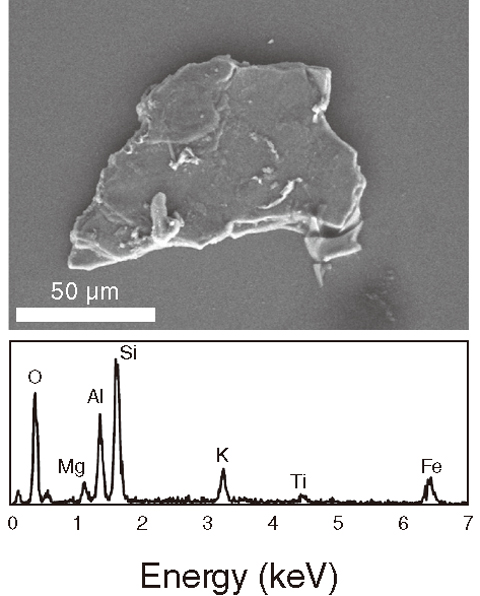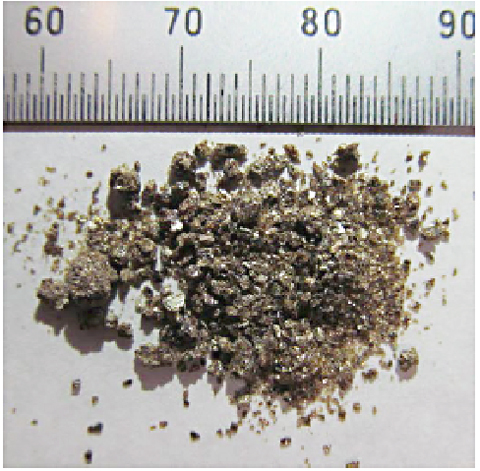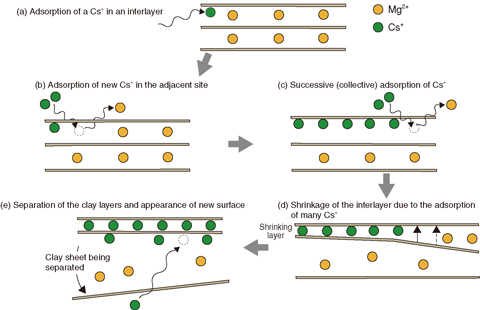
Fig.1-19 A microscope picture of radioactive fine particles (upper), and the chemical compositions of these particles determined by the X-ray emission spectrum (lower)

Fig.1-20 Widely seen clay mineral in Fukushima, vermiculite

Fig.1-21 Successive adsorption of Cs+ like “domino toppling” and schematics of the structural change of vermiculite
The accident at the TEPCO’s Fukushima Daiichi NPS has caused serious contamination of the surrounding environment. We have found the selective adsorption of radioactive cesium (Cs) onto weathered biotite (or vermiculite, Figs.1-19 and 1-20), which commonly occurs in Fukushima, and have clarified its successive adsorption mechanism (Fig.1-21), using a radiation-recording medium, an imaging plate (IP), electron microscope techniques, and small-angle X-ray scattering.
Weathered biotite has been considered to be a promising absorbent for radioactive Cs in real soil in Fukushina. We first collected soil contaminated with radioactive Cs at Iitate Village, Fukushima. The soil particles were put on IP and the radiation from each particle was recorded. On the basis of the images, the particles including radioactive Cs were then transferred to an electron microscope (SEM), and the structures and chemical composition were investigated. Consequently, we found that the particles containing radioactive Cs are categorized into the several types. After slicing the particulates into thin sections, we further analyzed the detailed micro-structures inside of the particulates using an electron microscope (TEM) with a higher resolution. Consequently, it became clear that most radioactive Cs was immobilized on the weathered biotite. In addition, the Cs ion (Cs+) in the real soil of Fukushima was not concentrated in the edge area of the micaceous particles but distributed homogeneously in this mineral, in contrast to the previous sorption-experimental results in the laboratory. In fact, much weathered biotite, deriving from the granite in the east part of Fukushima, occurs in Fukushima soil. Thus, there is a high possibility that a large amount of radioactive Cs in the soils of forests and rice fields is strongly trapped in this mineral.
We investigated the adsorption behavior of radioactive Cs and the structural changes in vermiculite clay with an increase in Cs+ concentration in dipping solution. Consequently, once one Cs+ adsorbed at a specific point of the vermiculite interlayer, the Cs+ and other ions with similar chemical properties tended to occupy the neighboring site in the same interlayer space. Finally substantial Cs+ adsorbed collectively in the selective interlayer spaces. Furthermore, there were electrostatic interactions in the clay interlayer space because of the Cs+ adsorption. The direct bonding of substantial positive Cs+ with oxygen atoms of the clay sheet, locally compensated for the layer charge of the clay sheet. Thus, the attractive interaction between the clay sheets on opposite sides of the interlayer was weakened. Consequently, the two clay layers were separated, and the newly formed surface of the separated layer potentially could work as an adsorption site of the other Cs+. Therefore, substantial amounts of Cs+ were adsorbed in the layer of vermiculite one after another like “domino toppling”. In order to investigate this mechanism at the atomic/molecular scale, the research group employed a method called “small angle X-ray scattering”. Consequently, it was found that the structure had changed, as shown in Fig.1-21.
These detailed results for a concentrated mineral and adsorption mechanism of radioactive Cs in Fukushima are expected to provide useful information for the Fukushima environmental recovery.